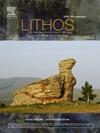含海蓝宝石花岗质伟晶岩的岩石成因:以巴基斯坦北部Haramosh伟晶岩田为例
IF 2.5
2区 地球科学
Q2 GEOCHEMISTRY & GEOPHYSICS
引用次数: 0
摘要
巴基斯坦北部的Haramosh伟晶岩油田以其大量的花岗质伟晶岩而闻名,其中含有大量的海蓝宝石、碧玺和黄玉。本文研究了含海蓝宝石伟晶岩的成因及其与围岩(Iskere片麻岩)和相邻侵入体(Jutial浅色花岗岩)的成因关系。伟晶岩主要由长石、石英、白云母和电气石组成,类似于s型黄斑石,内部分带,晶洞中形成宝石级海蓝宝石和黄玉。锆石UPb定年结果显示,伟晶岩年龄为4.3±0.9 Ma,浅花岗岩体年龄为10.3±0.2 Ma,与Iskere片麻岩(1881±27 Ma)明显不同。LuHf同位素数据表明,伟晶岩和浅花岗岩体具有共同的地壳源,εHf(t)值分别为- 35.9 ~ - 19.7(平均值= - 26.5)和- 29.5 ~ - 24.4(平均值= - 26.0)。这些结果与在Iskere片麻岩中观察到的结果(−16.0至+6.5,平均值=−6.0)明显偏离,从而排除了乡村岩石部分熔融模型的可能性。伟晶岩为lct型,SiO2 (71.53 ~ 77.17 wt%)、Al2O3 (13.50 ~ 15.82 wt%)、Li (14.62 ~ 224 ppm)、Ta (0.01 ~ 4.51 ppm)浓度高,ASI值(1.34 ~ 2.37),分异指数值(DI = 92 ~ 97)高于浅花岗岩体,K/Rb比值低于浅花岗岩体。碧石、斜长石和白云母的成分变化也表明伟晶岩中的岩浆演化程度高于浅花岗岩。伟晶岩斜长石中CaO含量沿边界向芯区递减,全岩Be浓度沿此梯度递增,说明在伟晶岩岩脉内岩浆演化过程中,Be逐渐富集。综合上述结果,我们认为哈拉莫什含海蓝宝石伟晶岩可能是由浅花岗质母岩浆岩浆分异结晶形成的。海蓝宝石的形成可归因于伟晶岩脉内岩浆演化过程中be的逐渐富集。与海蓝宝石相关的煌斑岩孔洞的广泛存在,以及从伟晶岩边界到岩心带电气石中氟含量的降低,表明在岩浆冷却的最后阶段参与了岩浆挥发相(MVP)析出过程。这一过程降低了Be在熔体中的溶解度,从而促进了海蓝宝石的结晶。本文章由计算机程序翻译,如有差异,请以英文原文为准。
Petrogenesis of aquamarine-bearing granitic pegmatite: The case of Haramosh pegmatite field (northern Pakistan)
The Haramosh pegmatite field in northern Pakistan is renowned for numerous granitic pegmatites, containing economically significant quantities of aquamarine, tourmaline, and topaz. This study investigates the petrogenesis of aquamarine-bearing pegmatite and its genetic relationship with the country rock (Iskere gneiss) and an adjacent intrusion (Jutial leucogranite). The studied pegmatite is composed predominantly of feldspar, quartz, muscovite and tourmaline, resembles the S-type Jutial leucogranite and shows internal zonation with gem-quality aquamarine and topaz forming in the miarolitic cavities. Zircon U![]() Pb dating yields ages of 4.3 ± 0.9 Ma for the pegmatite and 10.3 ± 0.2 Ma for the leucogranite, distinct apparently from the Iskere gneiss (1881 ± 27 Ma). Lu
Pb dating yields ages of 4.3 ± 0.9 Ma for the pegmatite and 10.3 ± 0.2 Ma for the leucogranite, distinct apparently from the Iskere gneiss (1881 ± 27 Ma). Lu![]() Hf isotopic data suggest a common crustal source for the studied pegmatite and leucogranite, with εHf(t) values ranging from −35.9 to −19.7 (mean = −26.5) and − 29.5 to −24.4 (mean = −26.0), respectively. These results significantly deviated from those observed in the Iskere gneiss (−16.0 to +6.5, mean = −6.0), thereby precluding the possibility of a partial melting model of the country rock. The pegmatite, classified as LCT-type, shows high SiO2 (71.53–77.17 wt%), Al2O3 (13.50–15.82 wt%), Li (14.62–224 ppm), Ta (0.01–4.51 ppm) concentrations and ASI values (1.34–2.37), with higher differentiation-index values (DI = 92–97) and lower K/Rb ratios than the leucogranite. Compositional variations of tourmaline, plagioclase and muscovite also indicate a higher degree of magma evolution in the pegmatite compared to the leucogranite. The plagioclase in the pegmatite displays a decrease in CaO content from the border to core zones, while whole rock Be concentrations exhibit an increase along this gradient, indicating a progressive enrichment of Be during magma evolution within the pegmatite dyke. Based on all results, we propose that the Haramosh aquamarine-bearing pegmatite was likely generated by magmatic fractional crystallization from a leucogranitic parent magma. The formation of aquamarine gems can be attributed to a progressive enrichment of Be during magma evolution process within the pegmatite dykes. The observed widespread occurrence of miarolitic cavities associated with aquamarine gems, coupled with the observed decrease of fluorine content in tourmaline from the pegmatite border to core zones, indicates the involvement of a magmatic volatile phase (MVP) exsolution process during the final stage of magma cooling. This process reduces the solubility of Be in the melt, thereby promoting the crystallization of aquamarine.
Hf isotopic data suggest a common crustal source for the studied pegmatite and leucogranite, with εHf(t) values ranging from −35.9 to −19.7 (mean = −26.5) and − 29.5 to −24.4 (mean = −26.0), respectively. These results significantly deviated from those observed in the Iskere gneiss (−16.0 to +6.5, mean = −6.0), thereby precluding the possibility of a partial melting model of the country rock. The pegmatite, classified as LCT-type, shows high SiO2 (71.53–77.17 wt%), Al2O3 (13.50–15.82 wt%), Li (14.62–224 ppm), Ta (0.01–4.51 ppm) concentrations and ASI values (1.34–2.37), with higher differentiation-index values (DI = 92–97) and lower K/Rb ratios than the leucogranite. Compositional variations of tourmaline, plagioclase and muscovite also indicate a higher degree of magma evolution in the pegmatite compared to the leucogranite. The plagioclase in the pegmatite displays a decrease in CaO content from the border to core zones, while whole rock Be concentrations exhibit an increase along this gradient, indicating a progressive enrichment of Be during magma evolution within the pegmatite dyke. Based on all results, we propose that the Haramosh aquamarine-bearing pegmatite was likely generated by magmatic fractional crystallization from a leucogranitic parent magma. The formation of aquamarine gems can be attributed to a progressive enrichment of Be during magma evolution process within the pegmatite dykes. The observed widespread occurrence of miarolitic cavities associated with aquamarine gems, coupled with the observed decrease of fluorine content in tourmaline from the pegmatite border to core zones, indicates the involvement of a magmatic volatile phase (MVP) exsolution process during the final stage of magma cooling. This process reduces the solubility of Be in the melt, thereby promoting the crystallization of aquamarine.
求助全文
通过发布文献求助,成功后即可免费获取论文全文。
去求助
来源期刊

Lithos
地学-地球化学与地球物理
CiteScore
6.80
自引率
11.40%
发文量
286
审稿时长
3.5 months
期刊介绍:
Lithos publishes original research papers on the petrology, geochemistry and petrogenesis of igneous and metamorphic rocks. Papers on mineralogy/mineral physics related to petrology and petrogenetic problems are also welcomed.
 求助内容:
求助内容: 应助结果提醒方式:
应助结果提醒方式:


